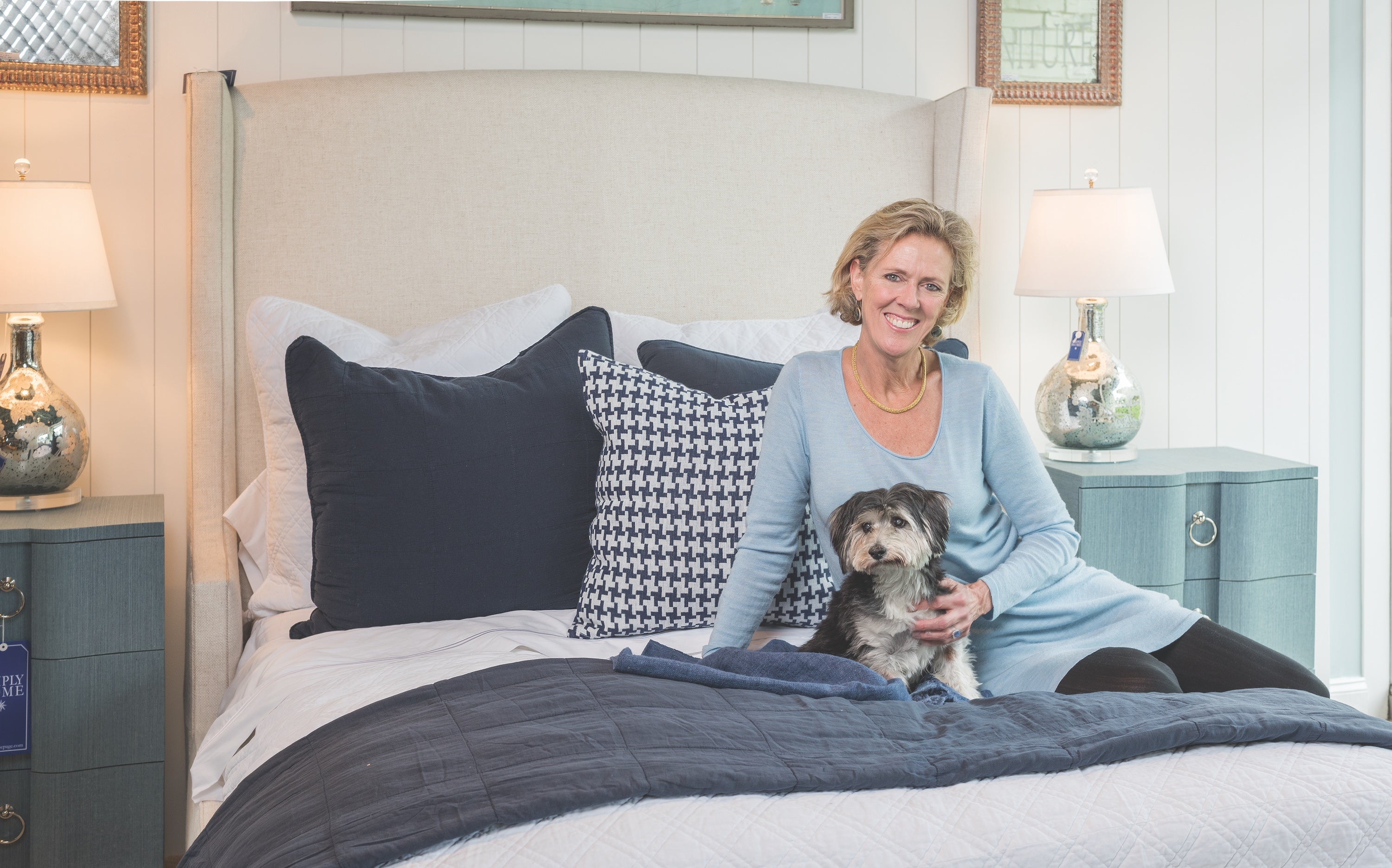The 50 States Project is a yearlong series of candid conversations with interior designers we admire, state by state. Today, we’re chatting with Linda Banks, who moved her bustling Connecticut design business to Maine in 1998. In addition to sharing images of a recent project, she talks about why investing in her brick-and-mortar space helped her business survive economic downturns, how one magazine cover got her decades of projects, and why debt can be the kiss of death for design businesses.
Maine is becoming a bit of a hot spot these days—a lot of people from the New York tri-state area are eyeing property there as they look to get away. But you’ve been there more than two decades now. What are you seeing?
So here’s the thing about Maine: There are 1.3 million people in the whole state—we’re naturally socially distanced! I think that what’s going to happen [with the coronavirus pandemic], much like what happened after 9/11, is everyone’s going to flee [the city]. And now that everybody knows there’s telecommuting or working from home, a lot of people will realize that they don’t have to be there as much; they will spend more time here and realize they don’t have to make that trip [back and forth].
In Brooklyn, there are nearly 37,000 people in one square mile; in Maine, there are less than 45. I’m not kidding! Portland is the biggest city in the state, and it’s only got 70,000 people. In greater Portland—that includes Cape Elizabeth, Yarmouth and Falmouth, where I live—all of the houses have been getting gobbled up for the last decade. I’ve been here 20 years, and for the first 10 it was pretty sleepy, and I was commuting back and forth to Connecticut. In the last 10 years, it’s become a little bit competitive. There are nearly 3,500 miles of coastline here, so we’ve built our reputation over these years on designing waterfront homes in a clean, classic style, from Maine to Florida.
You had a thriving business in Connecticut. What made you want to move in 1999?
I started Banks Design in Darien in 1984. My firm was successful and the economy was booming. I was speaking in Louisville, I had a client in Jackson Hole, a couple projects in Naples and one in Vero Beach—but I’m a single mom, and I was leaving my 6-year-old daughter Emma with the nanny all the time. I told myself, “I’m going to go for it now—do the HGTV thing and a possible line with Hickory Chair.” And I would look at my little daughter and be like, “I can’t.” I had 11 or 12 years of crazy success, and then in 1998, I just made this decision to get out of the passing lane and move to Maine to slow down—I was going to have the stone walls and lilac trees and a house on the ocean and all this stuff. I was practically going to retire. I wanted to be able to pick my daughter up at the bus stop.
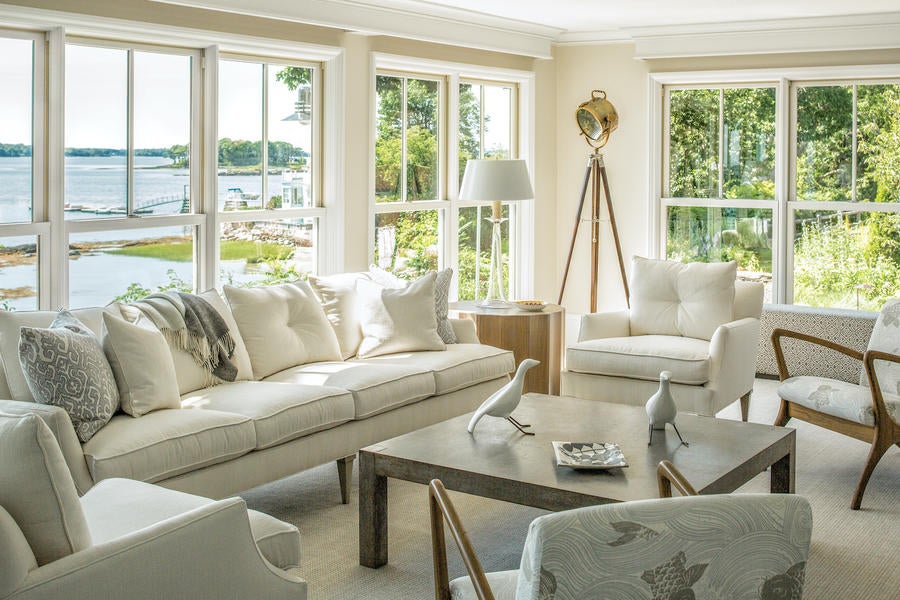
Why Maine?
I’ve been coming to Maine every summer since before I could walk. My mother’s from Maine—14 generations of Maine. So when I moved here, I started going to all the places for work that I used to go to for vacation. I’d be sitting on my client’s boat in the harbor going, “This is where I used to come look for boys in high school.” But even though I’m from 14 generations of Maine, I’ll always be “from away” to the people here because I was born in Greenwich.
I want to rewind for a moment. Tell me about how you built your firm in Connecticut.
I had a great education, and after school, I was working as a junior draftsman for an architect in Darien. On the side, people would ask me to draw up a kitchen for them or do a family room addition—but it got to the point that I was doing all this stuff on the side and then falling asleep at the office because I was staying up until 2 in the morning. And so I went off on my own.
This is what I say: “What on earth industry could you start in your attic with a pencil and make money?” I had an architecture business in the beginning—I was doing new houses for builders—“drafting for dollars,” I called it. I’d do family room renovations and kitchens, and it just grew. I took on a partner for a while—I was much more interested in the design and client side, and he was really good at the production drawings side, so we were a good team. We were together for about five years, but we didn’t really see eye to eye, so I went back on my own.
We had done the architectural design of five spec houses in the Middlesex Farm development in Darien. In 1988, the Special Olympics partnered with the builder on a showhouse at Middlesex Manor, the main house at the beginning of the subdivision, to raise money for the Special Olympics and to promote the new subdivision. We did the master bedroom suite, which won an ASID competition. We also got five design clients from that one room, which launched the decorating part of the business. That was the year I got my NCIDQ accreditation and joined ASID.
You’ve been doing architecture and design since then?
I had studied in Copenhagen for a year and then worked for my professor in Barcelona, and I always wanted to have that European-style atelier where there’s no differentiation—you do architecture and interiors, and they’re one and the same and you’re proud of both. But I needed a team [to make that happen], so the firm grew again to include two interior designers, a registered architect and myself. We really shared the design—I always loved creating the ideas, and then those guys would help me execute. We were together for 10 or 11 years. We all had the same style, kept getting published, won a lot of awards, and it was just a great time.
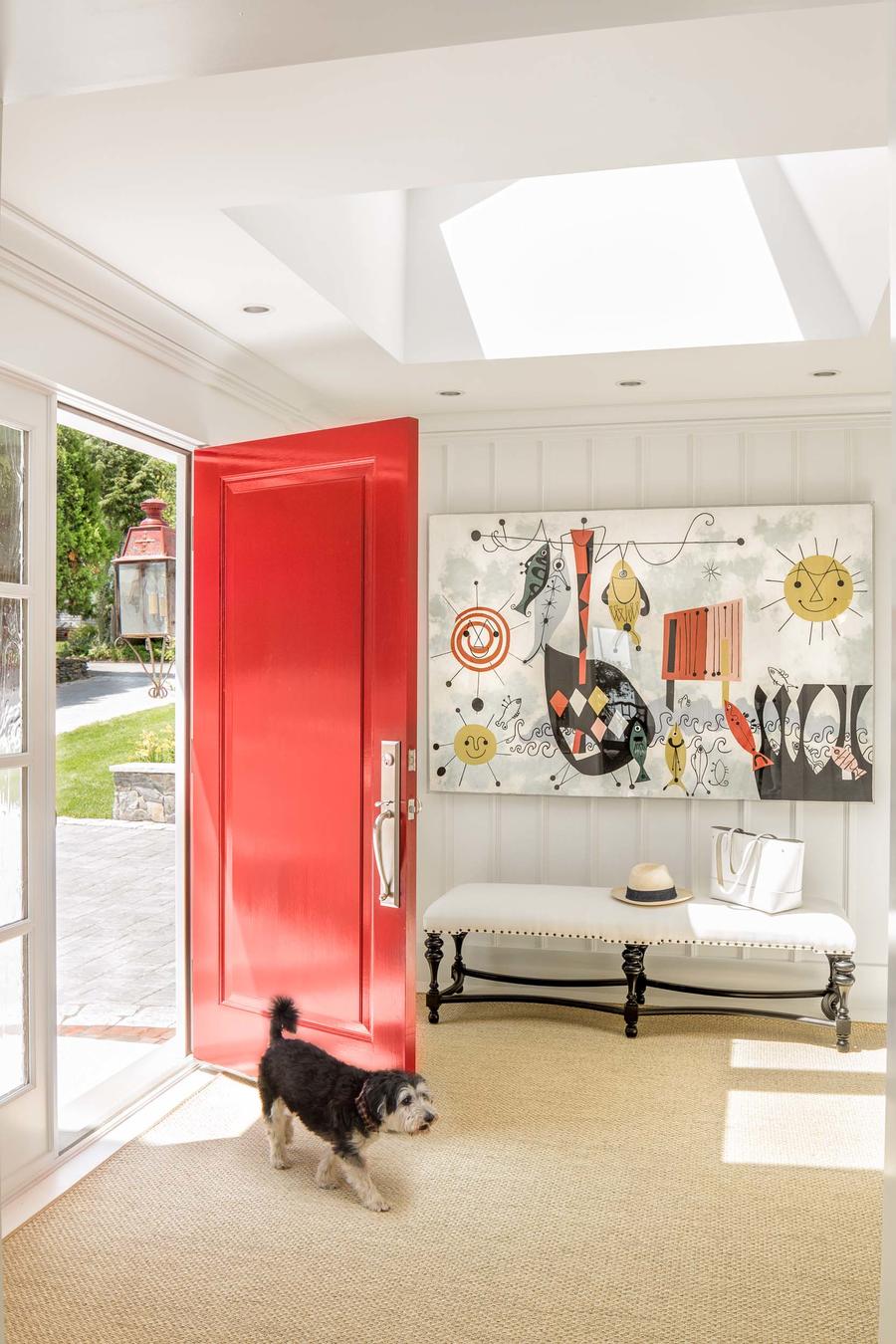
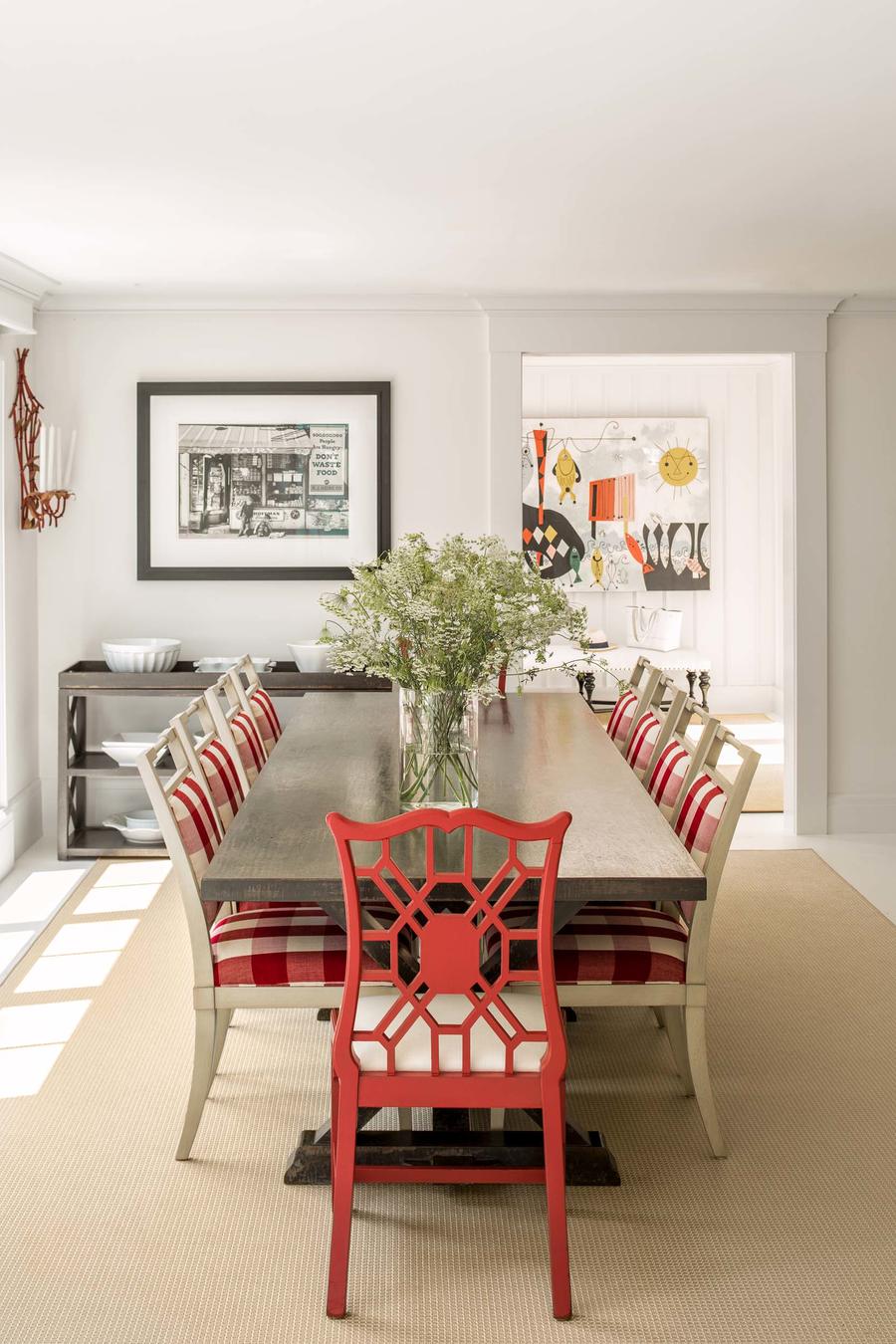
Tell me about the publishing landscape then.
Back in the day, the saying was “Publish or perish.” My first cover was Decorating and Remodeling—this blue-and-white kitchen with a stone wall. Back then, every one of those Meredith [special issue publications] was jammed with ads, content and great photography. When I was at the Kitchen & Bath Industry Show one year, I snuck into the press office—and everybody had a mailbox! There were little cubicles and [all the editors] would get their press kits stuffed in there. I stuck scouting shots that I made and printed with a note that said, “I’m Linda Banks, from Rowayton, Connecticut, and I have this kitchen in an old house.” That’s how I got that cover.
Did that lead to other press?
The biggest break early on was my first cover story at Traditional Home, a gorgeous new house we designed on Long Island Sound. I loved walking through Grand Central Station and seeing that cover on the newsstands, and I got calls from all over the country—for speaking engagements, more design work and a couple of HGTV gigs. I thought it was my “15 minutes,” but I continued to get calls from that story for at least 10 years and am still good friends with those clients to this day.
I’ll tell you a crazy story. I was at a cocktail party at the Mill Reef Club in Antigua about 10 years after that story came out, and I met this couple—they were really attractive, a little bit older, blonde, very preppy, and he kept looking at me, squinting his eyes. At one point, he motioned me to come over, and I’m thinking, “Is he going to hit on me?” And then he goes, “Can I ask you a question?” He pulled out that cover of Traditional Home, which was all folded up in his wallet—
He had it in his wallet?
In his wallet! Folded up for like 10 years. This is a true story! And he said, “Is this you?” I said yes. And he goes, “What are you doing next weekend? I’m buying a house in Palm Beach. I’ve been saving this [story] for 10 years—will you fly down to meet with us? I am obsessed with this, and we want you to do our house, but I haven’t told my wife yet that I’m buying it for her.”
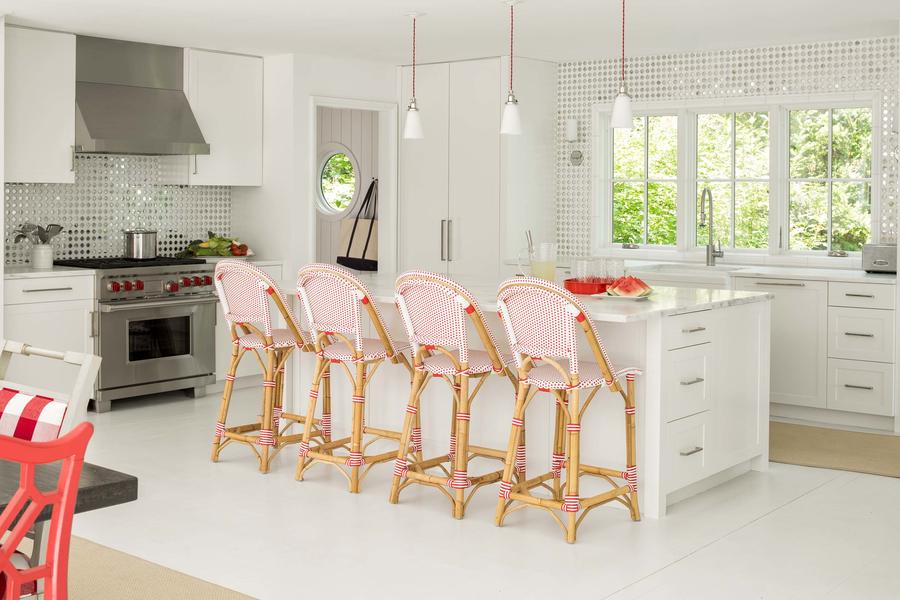
That’s amazing. So you put down roots in Maine, but you were still coming back to Connecticut for work—and still taking projects all over?
I commuted back to Connecticut for six years. Then, finally, I just couldn’t keep doing it. I gave each of my three partners a piece of the business as well as the [firm’s] phone number. They had earned it! When I left, I felt like I really left the firm in a good strong place—like I had built that and passed the baton.
And then what?
Well, it took six years of overlap to fully wean myself, commuting back and forth, but at the same time I had always dreamed of being a little shopkeeper—a store that had a sign in the window: “Open by chance or appointment.” [Los Angeles–based design business consultant] Keith Granet was consulting with me on how to reinvent my business life at the time—I wanted to do more than just design new homes, do renovations and decorate. I was very curious about purchasing furniture directly and not having to go through the design centers; I had a feeling I could demystify the process for myself if I had a shop. And now I’ve had my store, Simply Home, for almost 20 years.
Within three years of setting up shop, we were the largest interior design firm in Maine. Plus, it turns out a lot of my Connecticut clients had homes—or wanted to build homes—in Maine. Fifty percent of my work comes from Maine now; the other 50 percent of it comes, as we say here, “from away.”
Tell me more about deciding to open the shop.
When I realized the spaces I liked were all $7,500 a month to rent, I started to think, How much would it cost to buy something? I thought I could get a comparable space for a much lower monthly outlay. I found this 6,000-square-foot cinder-block freestanding building on Route 1 in Falmouth, right outside of Portland—and funnily enough, it was an upholstery workroom and a furniture showroom. The people who owned it were from Connecticut, and they’d had it for 27 years. They had run out of steam, but it was the only game in town. Keith and I put together a deal, and I bought the inventory, the building and the goodwill. And then we spent a lot of money updating the building and added a 2,000-square-foot warehouse that looks like a barn.
My business plan was to have four streams of income: a showroom for other designers; selling to the retail customer; supporting our private design clients; and then we had the workroom. We eventually outsourced the workroom, but that was part of the original plan when we bought the building.
Now, I am less than a year away from owning the building outright. The real estate has tripled in value—if my company had to rent that building today, it would cost us $13,000 a month, but the mortgage payment is significantly less than that. So, not only do I have long-term rental income if I ever retire, but I don’t run the risk of losing my space if I can’t pay the rent for a few months. I highly recommend it—it’s how we survived 9/11 and the recession in 2008.
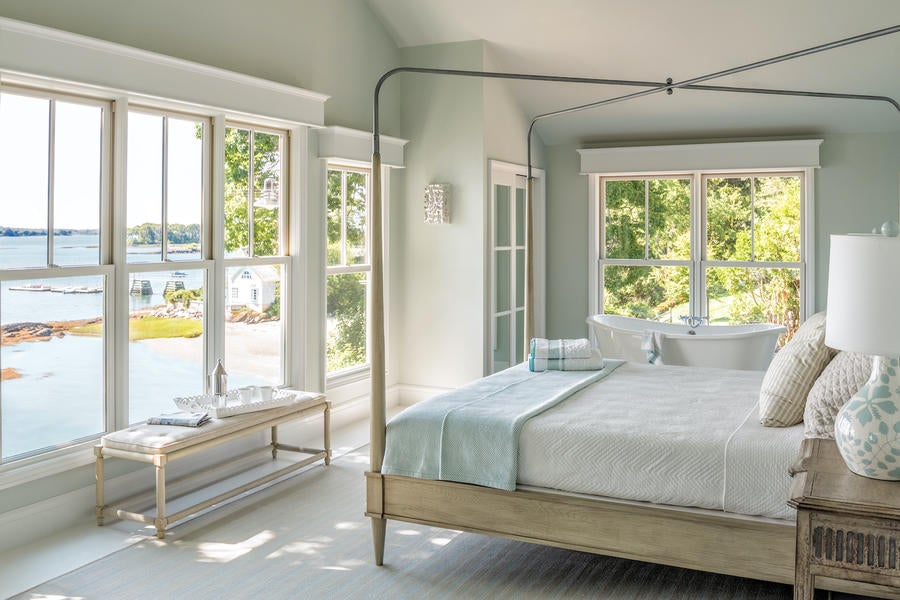
Did you change anything about the branding, or did you keep all of the existing intellectual property of the business intact?
I kept nothing. I was solely interested in this building to create a new identity, but was lucky enough to inherit an upholsterer and a designer. I spent a long time trying to come up with a name—I still have all of the three-foot strips of yellow trace with every possible name. Every name seemed so silly! When we first opened, we were called Simply Home and Cottage, but we quickly dropped the cottage, and I’m so glad we did.
A lot of people name the company after themselves, but I wanted to separate the brand of Banks Design from the Simply Home store. We’ve always struggled with how to advertise the two, and it’s definitely a challenge that I don’t think I’ve ever completely solved. So the store gets customers who might have no idea who I am, but when Banks Design clients come [into the store], they [are in awe]. It’s very weird—it doesn’t matter how much I’ve been published—the credibility of having the brick-and-mortar is very powerful. I’m very proud of how beautiful the store is, and people comment on it all the time.
What are the challenges?
I have a love-hate relationship with the store, because it costs me a lot of money. I own all my inventory, which is very important. I’m the daughter of a small-town bank president, and I’m really an advocate of minimal debt. There are a lot of designers who borrow from Peter to pay Paul, but that is the kiss of death. I feel like the design business is this huge pot of stew and some things cook down faster than others. Some jobs go really smoothly, and with some, every other thing goes wrong and you can’t control it. This business is 90 percent out of our control. What I can control is when we meet and what we do with your money and we get 100 percent up front for everything. We are not a bank. Every time we get money from our client, we put aside the money for the goods, and we live off the design fees and the margins. That’s how we operate our business.
What was the original business plan for the shop, and how has that changed?
It’s changed a little bit, in that there was no Restoration Hardware or Wayfair when we opened. We had planned to open in September 2001—our carpet was in a truck on the Tappan Zee Bridge when the Twin Towers fell. But then who wanted to come to a party at a couch store [after that]?
So you didn’t open?
It was not important to open a furniture store—it just wasn’t. I had what I called a soft opening over two months. But nobody had seen anything like it in Maine. Unlike all of the furniture stores, we weren’t open on Sundays. We had a design studio and the furniture showroom. I became a Lee dealer. Today, I carry four upholstery lines: Lee Industries, Hickory Chair, Vanguard Furniture and my own line with Robin Bruce, which is the higher-end division of Rowe.
Along the way, we kept getting calls from people who knew about us from those old days of getting published. And then as I approached my 50s, a lot of my clients were starting to downsize, selling that big house I did for them in New Canaan, or that classic six on Central Park West—and they were selling them for upwards of $10 million! So I started doing clients’ downsized homes—although, let me tell you, most people who think they’re downsizing end up in the same-sized place but with nice lighting, better windows and guest suites for their adult kids and grandchildren.
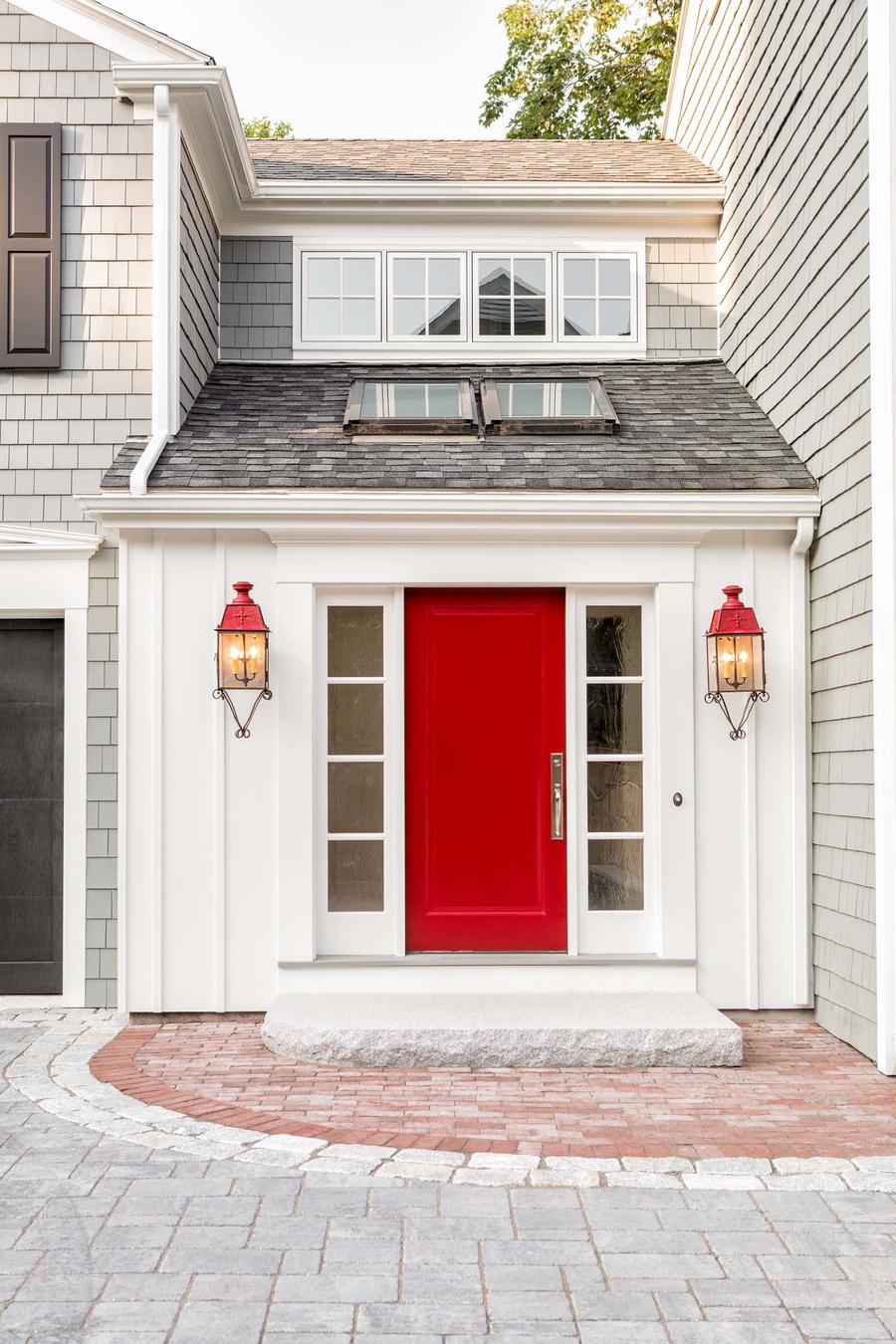
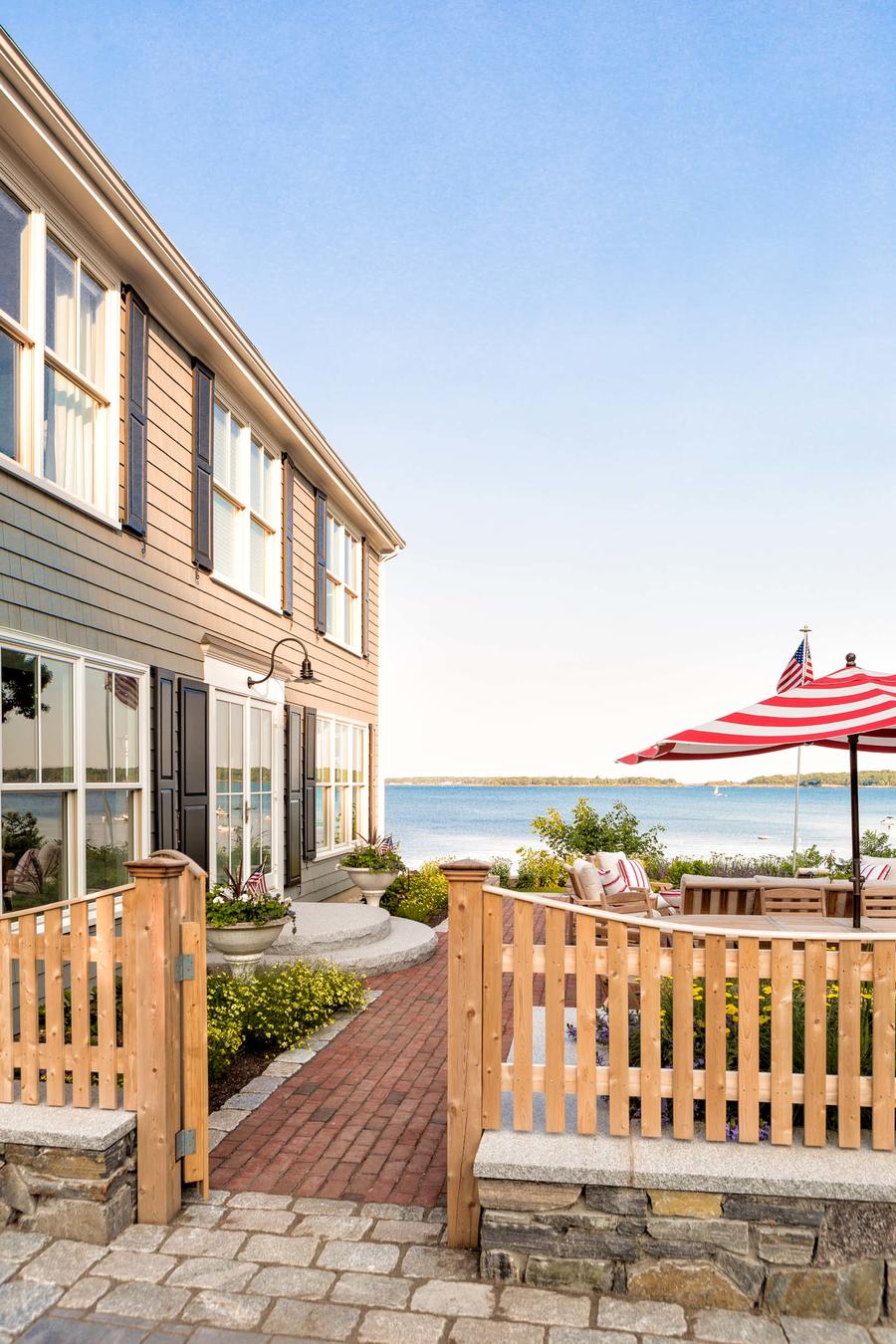
Tell me about your line.
It’s what I call the Colorforms version of decorating: I have my five favorite sofa frames and my five favorite chair frames, and then my 25 favorite performance fabrics and printed linens, and I’ve made it into a collection. We created it at High Point in October 2019 and launched it on our floor in the first quarter of 2020.
People have a choice of where they can shop, and over the years, I’ve stopped trying to talk people into doing COM as a cost-saving measure. It used to be that no one wanted the fabrics that came with the furniture—you had to get your own. But the fact is, the fabrics from Lee, Hickory Chair, Vanguard Furniture and Rowe are beautiful. They’re performance, they’re cleanable, they’re fresh. They have boutiquey, vacationlike, printed linens. They have everything you used to go COM for! Say the sofa is $3,700—you’re also going to buy 25 yards [of fabric] at $200 to double the price of the sofa? Not anymore. I always tell my clients, “Here’s three rows of hanging fabric samples that are 10 feet tall—I’m sure you can find something in here that we can work with.” And then we usually go COM on the pair of chairs.
In other words, I think that [given] the four wonderful American-made upholstery lines that we sell, you’ve got a problem if you can’t find something between the printed linens, the cotton velvets, or the performance fabrics they offer. We don’t typically decorate with the fabric, anyway—we use a great rug or painting as the driver of each room. We might use the headboard fabric as a driver, in which case we would probably go COM. But we use it very judiciously, and we treat it like it’s very special.
My friends who own other stores, they think it’s brilliant to sell COM fabric. They’re like, “We want to build that sale. Clients want that mohair, so we sell that sofa and the COM mohair!” But you know, at the end of the day, I’m also the architect. I have to juggle the budget for the whole house first—and I know a lot of designers won’t work for a budget of less than a million, but we can do a lot for a couple hundred thousand inside. I would rather have them get more stuff than spend it all in one room.
How are you doing in this climate? Has business been slower?
Considering that we’ve been closed for the past eight weeks, I have to tell you, we have had a couple of record months. We’re planning to reopen on June 1, and just ordered a big sign that says, “Welcome home.”
What drove that success?
It was three things: We had a client from Brooklyn in the pipeline who had deferred her orders for their summer house in Maine all winter, and they finally pulled the trigger in March and April. Then one of our favorite outside designers called and needed a whole house of furniture. They bought 30 pieces off the floor in one FaceTime conversation. And then we had this sofa stimulus: We did a couple of witty email blasts to our database with the message, “Who says a sofa isn’t essential?” The first five callers could pick one of our sofas off the floor for 50 percent off, and then we donated $100 for each sofa to feed kids in Maine. We actually sold six sofas that day—and then somebody got the email from their friend in Boston, and they ended up hiring us to decorate their house.
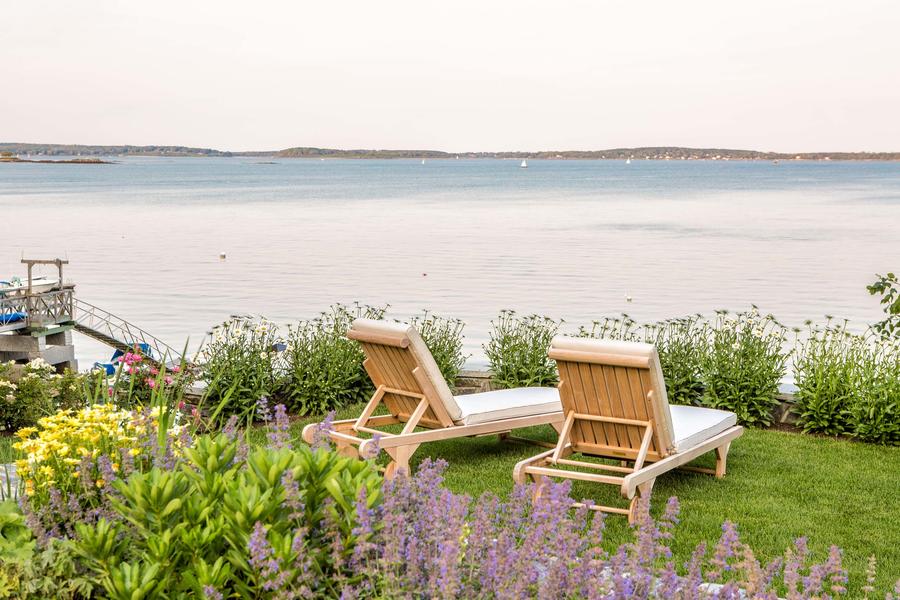
That’s great. Are you feeling optimistic about weathering the coronavirus, then?
Saturday, my client called me and was like, “What are you going to do with the store?” And I said, “Oh, I’ve reinvented it—I’m going to be [selling] building products and decorating.” There are a lot of people who work with a builder but haven’t engaged a design firm, but they can get help from our store specifying building products without having a contract with an interior designer.
How did you land on that path forward?
I started looking at who my top spenders were last year, and it was all my design clients. We charge for the installation, or if we have to travel, but mostly we charge a design fee per room—I always like to say that covers the creative portion of the process—and then we count on them buying from us, and that’s how we get paid. So when you look at an architecture job, I have a fee for the design, but we also sell those hard pieces. Two-thirds of their spend with us is the soft goods, but the other third is assorted building products like cabinetry, lighting and hardware.
I realized that people who don’t know who I am or what I do come into the store and think that they can buy lamps, candles and a couch. But we also represent Emtek hardware, Lacava vanities, Hunter Douglas, an American-made mattress company, Visual Comfort and Hudson Valley Lighting. Someone who walks into the store might not even know we have the architecture arm—and they might not need it, but maybe they’re building a house and they don’t know that we could offer those things.
How do you go about changing that in the shop?
We’re going to take a piece of this big building and make a display of the vanities and hardware we like. It’s not all of the Emtek hardware, but the stuff we picked out that is our look. I’m not going to sell a light fixture I don’t like. I think it’s like a menu—when you go to a restaurant, you don’t have access to everything in the supermarket; they’ve edited it and made it just for your food. The food that they want to prepare for you. So we will create a curated collection of building products and interior furnishings, where if someone came along and took the whole thing and just put it in their house, they’d get the look.
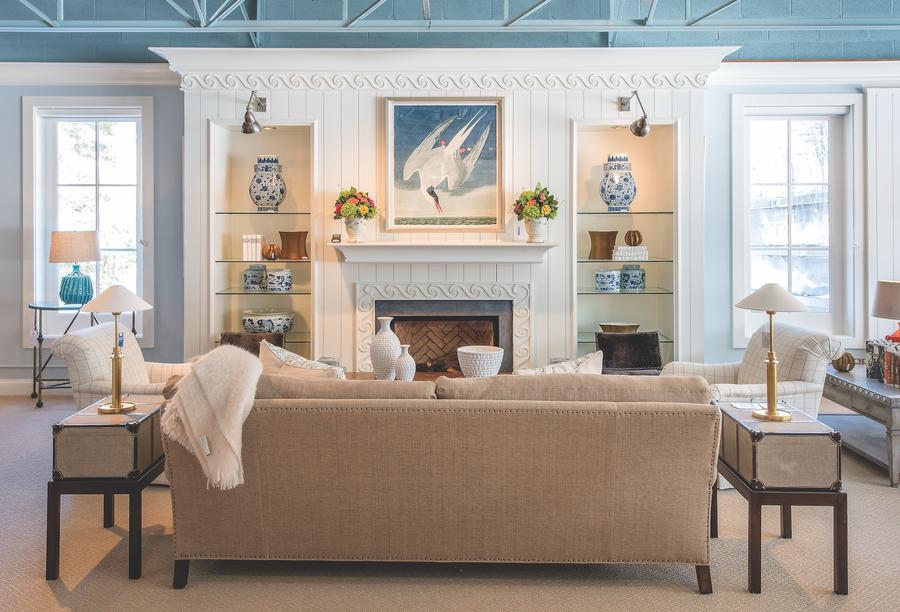
Looking at the current landscape, would you open your shop today?
I would not open a retail home furnishings store today. A retail furniture store is an outdated business model—it doesn’t work. But I’m a high-end residential home furnishings showroom that showcases my design style. And as a result, each side of the business feeds the other—it’s the one business model that our road and sales reps say is making it work. [The big-box furniture stores] have 17 salespeople and they train them to sell furniture, but they’re not passionate and they don’t have design expertise. We’re all in it because we love design, we love what we do, we are professionals, we have accreditation, and we know what we’re doing—and I know it shows.
So, no, I wouldn’t do it now—but I also wouldn’t trade it. I will give you a classic example [of the opportunities it creates]. One Saturday at quarter of 5, the day before Easter, I was working in the store with my assistant when one of our state’s [former] U.S. senators walked in. He hired us from the store, and we did his entire house in Northeast Harbor. And they were great clients. When I’m in the store, I’ll chat people up—I find the personal connection is so important. I remember once we were having a birthday party for my finance manager and I heard the doorbell ring. I went out to answer the door with a beer and was like, “Hi, we’re having a birthday party—you guys want a beer?” I did the whole house for them—and they had just pulled in on their way to the airport.
I know there are a ton of other people out there who would kill for this job, so I never forget that. My grandfather always said, “People do business with people they like.” That’s me and my clients. I mean, at the same time, I sometimes wish I could be Samantha in that TV show Bewitched and wiggle my nose and have a five-minute run-through [and get] the house done and then they’d leave me alone for the next two years. But it doesn’t work that way. You have to be a marriage counselor, a travel agent and a shrink in this job. You have to be a diplomat. It’s also a long-term, family-centric business if you do it the old-fashioned way like I do—I can recommend the hair lady when they move here, the best baker and the best doctor.
How do you stay inspired?
I travel. I’ve lived in France every August for the past 30 years on a tiny island—this little sandbar town at the end of an island in the Atlantic Ocean. I’m inspired by the light, everything’s pale blue—it’s that sort of seaside atmosphere that soaks in the salt. It’s very special. For a month, I think about my projects, talk to my clients, stay up really late, eat and draw, and I just get fueled. I just think. And everybody is like, “Oh, you’re so lucky to go to France.” And I go, “No, I’m not lucky. I planned this.” It’s as important to my clients’ jobs as it is to my sanity. “Oh, that must be nice,” they say. And I say, “It’s very nice. You should try it.”
Do you shop there as well?
I’m so over that! You can get all that stuff here! I used to bring home dishes and go to Blanc d’Ivoire on my way out of town and get two matelassé coverlets. Now, I’m telling you, you can buy matelassé coverlets at Target. I loved those things for years, but sometimes they look out of place here. The whole French Provincial look that everybody loved back in the day when Pierre Deux was on Madison Avenue, that’s gone. Nobody wants that! I have no use for my clients’ antiques that their children don’t want. I can’t give away brown furniture.
That’s funny. Do the clients want to get rid of it too, or are they attached to it?
A friend recently sent me pictures of all the stuff in his big house on the ocean in Rockland, and he goes, “I know you’re a designer. Do you know what I could do with all this stuff?” He sends me 45 pictures of brown furniture and red-and-blue oriental rugs. I go, “Your collection is stunning—have you asked your children if they want it?” He goes, “Oh, no, they don’t want it.” Well, neither do my clients. The reason you don’t want it is the same reason your kids don’t want it. My clients try to say, “We don’t really have room for this,” and I’m like, “No, you actually just don’t like that anymore.”
What’s the game plan for the store and for the business?
I’ll stay at least five or 10 more years, I think. But I’ll always be a consultant. I’ll always have my pencil. I started with my pencil and I’m going to end with my pencil.
To learn more about Linda Banks, visit her website or find her on Instagram.
Homepage photo: Linda Banks and Beasley | Francois Gagne
















